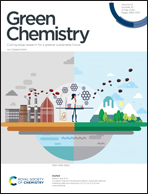Molecular engineering low-surface energy membranes by grafting perfluoro-tert-butoxy chains containing fluorous silica aerogels†
Abstract
The recent attention on perfluorinated superhydrophobic membranes has been accompanied by growing concerns over the potential degradation of longer than C6-perfluoroalkyl chain containing compounds in the environment to form bioaccumulating perfluoroalkyl acids. While maintaining the superhydrophobicity of the membrane, we have addressed the problem of bioaccumulation by immobilizing perfluoro-tert-butyl groups on the commercially-available aerogels. The resulting fluorous aerogels were electrosprayed on the top of commercial PVDF membranes to fabricate superhydrophobic membranes. The effects of varying the alkyl chain between the aerogel and the perfluoro-tert-butoxy groups and the concentration of the modified aerogel were studied to identify the optimal membrane for membrane distillation (MD). The fabricated membranes were tested for MD performance with sodium dodecyl sulfate (SDS) and saline water (3.5% NaCl). The F1-SiG100 membrane (prepared by grafting 300 mg of 1-(nonafluoro-tert-butoxy)-4-butylethoxysilane aerogel on 300 mg of PVDF-HFP) exhibited superhydrophobicity (water contact angle = 151.2°), a very rough surface (Ra = 2.17 μm), and an extremely low surface free energy (0.82 ± 0.17 mN m−1). It also showed high resistance to low surface energy feed of up to 0.5 mM SDS and saline water.



 Please wait while we load your content...
Please wait while we load your content...